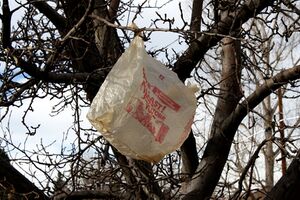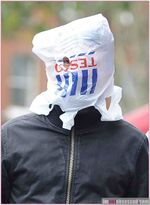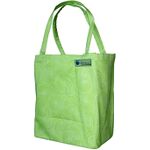Plastic bag
 A plastic bag in its natural surroundings. | |
| Status | Endangered |
|---|---|
| Classification | Bag |
The plastic bag (Latin: bag made out of plastic) is a creature that commonly lurks in public places such as parks, alleyways, and landfill sites. The species is characterised by its thin outer layer of skin, which can fill up with and let out air to aid movement; and handles, which allow the species to grasp onto tree branches to rest. The plastic bag has been classified as endangered since 2005, where it was decided that excessive recycling had put the species at risk.
History[edit]
Plastic bags have been captured by humans since the early 1900s, and because of their item-carrying ability, they quickly grew in popularity among the public. Farmers began to breed plastic bags to capitalise on this new marketplace, and the population increased. Plastic bags are bred in large greenhouses, to prevent them from escaping and roaming free, and survive through photosynthesis of sunlight. When it has reached adulthood, the bag is drugged to make it docile and shipped to supermarkets all around the world. Since the 1970s, bags have often been marked with the logo of the supermarket they are being shipped to, which has created a lot of controversy with animal cruelty groups, who call the process "unnecessary and barbaric".
Illegal bags[edit]
Ever since they became popular, governments from all around the world have had to deal with illegal plastic bags being sold through black markets and reaching widespread circulation. As they often come from developing countries, with little to no regulation, these bags can be infected with diseases and can even turn on their users and attack. Because they look the same as ordinary plastic bags, identifying them can be very difficult without significant expertise in the field.
Several organisations have been created to deal with the problem. The UNAIPB (United Nations Against Illegal PLastic Bags) organisation has cracked down on many illegal plastic bag farms all around the world, ordering them to close down. It is estimated that 20% of all plastic bags are of illegal origin.
There have been several high-profile cases of illegal plastic bags attacking people, for example Brown vs Plastic bag was a court case that ended with several bag farms being shut down. The exposure these cases have given to the issue have risen public awareness substantially.
Endangerment[edit]
Due to recent efforts to recycle more, the plastic bag has suffered a great decline in numbers, so much so that in 2005 they were classified as endangered. The bag is often melted down and used to create other items, in a process animal rights groups have called "cruel". Fundraising drives have taken place to try and reverse the problem, however so far efforts have been futile.
Several laws have been created to curb poaching and recycling of plastic bags, such as the 2003 Bag Conservation Act in the UK. However, there is a lot of debate whether or not these laws do enough.
Predators[edit]
The plastic bag has only one natural predator, the reusable shopping bag. Usually made from a material such as canvas or woven synthetic fibres, these bags will attack plastic bags, devouring and absorbing it into itself. More recently, these have become more popular than plastic shopping bags, and whilst they don't yet outnumber the traditional plastic bag, scientists predict that by 2025 they will do.
The reusable shopping bag lives in a similar habitat to the plastic bag, creating competition for resources and killing off the species. Culls have taken place to try and reduce numbers and restore balance, but this in itself has drawn criticism.

